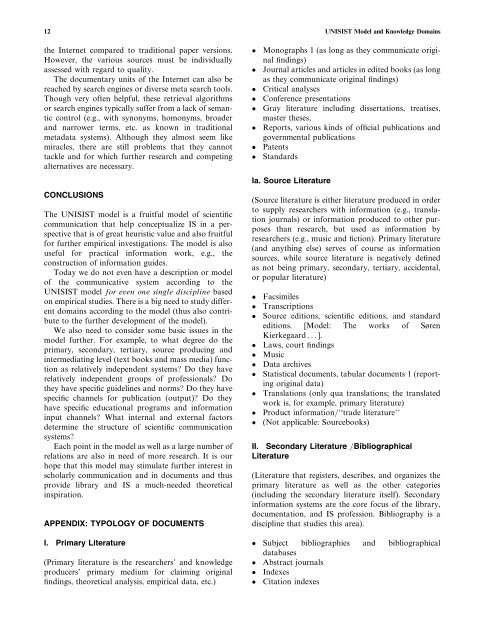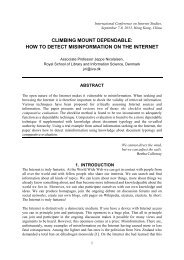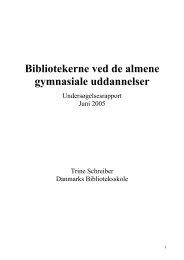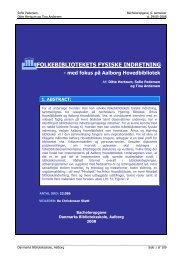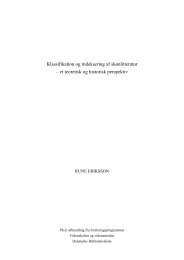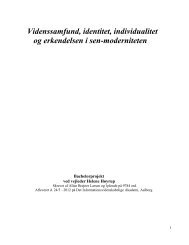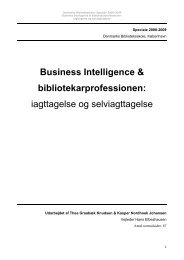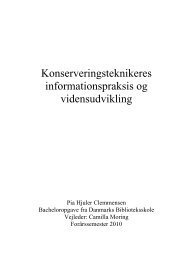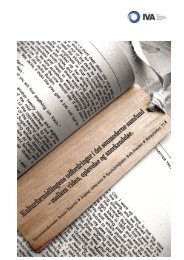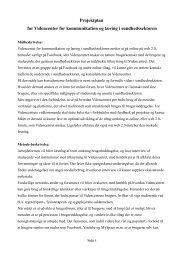UNISIST Model and Knowledge Domains
UNISIST Model and Knowledge Domains
UNISIST Model and Knowledge Domains
You also want an ePaper? Increase the reach of your titles
YUMPU automatically turns print PDFs into web optimized ePapers that Google loves.
12 <strong>UNISIST</strong> <strong>Model</strong> <strong>and</strong> <strong>Knowledge</strong> <strong>Domains</strong><br />
the Internet compared to traditional paper versions.<br />
However, the various sources must be individually<br />
assessed with regard to quality.<br />
The documentary units of the Internet can also be<br />
reached by search engines or diverse meta search tools.<br />
Though very often helpful, these retrieval algorithms<br />
or search engines typically suffer from a lack of semantic<br />
control (e.g., with synonyms, homonyms, broader<br />
<strong>and</strong> narrower terms, etc. as known in traditional<br />
metadata systems). Although they almost seem like<br />
miracles, there are still problems that they cannot<br />
tackle <strong>and</strong> for which further research <strong>and</strong> competing<br />
alternatives are necessary.<br />
CONCLUSIONS<br />
The <strong>UNISIST</strong> model is a fruitful model of scientific<br />
communication that help conceptualize IS in a perspective<br />
that is of great heuristic value <strong>and</strong> also fruitful<br />
for further empirical investigations. The model is also<br />
useful for practical information work, e.g., the<br />
construction of information guides.<br />
Today we do not even have a description or model<br />
of the communicative system according to the<br />
<strong>UNISIST</strong> model for even one single discipline based<br />
on empirical studies. There is a big need to study different<br />
domains according to the model (thus also contribute<br />
to the further development of the model).<br />
We also need to consider some basic issues in the<br />
model further. For example, to what degree do the<br />
primary, secondary, tertiary, source producing <strong>and</strong><br />
intermediating level (text books <strong>and</strong> mass media) function<br />
as relatively independent systems? Do they have<br />
relatively independent groups of professionals? Do<br />
they have specific guidelines <strong>and</strong> norms? Do they have<br />
specific channels for publication (output)? Do they<br />
have specific educational programs <strong>and</strong> information<br />
input channels? What internal <strong>and</strong> external factors<br />
determine the structure of scientific communication<br />
systems?<br />
Each point in the model as well as a large number of<br />
relations are also in need of more research. It is our<br />
hope that this model may stimulate further interest in<br />
scholarly communication <strong>and</strong> in documents <strong>and</strong> thus<br />
provide library <strong>and</strong> IS a much-needed theoretical<br />
inspiration.<br />
APPENDIX: TYPOLOGY OF DOCUMENTS<br />
I. Primary Literature<br />
(Primary literature is the researchers’ <strong>and</strong> knowledge<br />
producers’ primary medium for claiming original<br />
findings, theoretical analysis, empirical data, etc.)<br />
Monographs 1 (as long as they communicate original<br />
findings)<br />
Journal articles <strong>and</strong> articles in edited books (as long<br />
as they communicate original findings)<br />
Critical analyses<br />
Conference presentations<br />
Gray literature including dissertations, treatises,<br />
master theses,<br />
Reports, various kinds of official publications <strong>and</strong><br />
governmental publications<br />
Patents<br />
St<strong>and</strong>ards<br />
Ia. Source Literature<br />
(Source literature is either literature produced in order<br />
to supply researchers with information (e.g., translation<br />
journals) or information produced to other purposes<br />
than research, but used as information by<br />
researchers (e.g., music <strong>and</strong> fiction). Primary literature<br />
(<strong>and</strong> anything else) serves of course as information<br />
sources, while source literature is negatively defined<br />
as not being primary, secondary, tertiary, accidental,<br />
or popular literature)<br />
Facsimiles<br />
Transcriptions<br />
Source editions, scientific editions, <strong>and</strong> st<strong>and</strong>ard<br />
editions. [<strong>Model</strong>: The works of Søren<br />
Kierkegaard ...].<br />
Laws, court findings<br />
Music<br />
Data archives<br />
Statistical documents, tabular documents 1 (reporting<br />
original data)<br />
Translations (only qua translations; the translated<br />
work is, for example, primary literature)<br />
Product information=‘‘trade literature’’<br />
(Not applicable: Sourcebooks)<br />
II. Secondary Literature =Bibliographical<br />
Literature<br />
(Literature that registers, describes, <strong>and</strong> organizes the<br />
primary literature as well as the other categories<br />
(including the secondary literature itself). Secondary<br />
information systems are the core focus of the library,<br />
documentation, <strong>and</strong> IS profession. Bibliography is a<br />
discipline that studies this area).<br />
Subject bibliographies <strong>and</strong> bibliographical<br />
databases<br />
Abstract journals<br />
Indexes<br />
Citation indexes


